Juniper creeping: features of care and reproduction
A creeping or horizontal juniper is a dwarf shrub, therefore it does not grow in height above 10 cm, its needles are light green in color. The plant loves the open sun, only common juniper can grow in the shade and not lose its decorative properties. The shrub easily adapts to any type of soil and does not require a lot of moisture, it grows calmly in rocky areas.
Content
Description of creeping juniper
The creeping juniper is considered one of the most valuable among the rest. coniferous shrubsand also among the rocky corners. Although the plant is called a creeping juniper, the species is not at all similar to other representatives that we are used to seeing in our forests.
The branches of the plant spread along the ground, they are densely covered with either scales or shortened needles.
With the help of creeping juniper, compositions from other plant species can be supplemented, the needles are pleasant to the touch, soft, and can have a variety of shades, which is why it is so appreciated by amateur gardeners and professionals. The plant is not very demanding on growing conditions and in turn creates a pleasant atmosphere, emitting a delicate coniferous aroma.
Now the plant is cultivated all over the world. Under natural conditions, it grows only in North America, wrapping its branches with the banks of rivers and lakes, the slopes of mountains and hills.
The horizontal shrub has many varieties, consider those that are successfully grown by gardeners:
- Douglas is the lowest of all creeping representatives. As it grows, it forms a low carpet, the needles have a pronounced scaly structure and a steel-blue hue.
- On the territory of our country, the feathery variety is also widespread. It is slightly taller than Douglas and its needles are slightly longer, they separate from the shoot and are needle-shaped. In the fall, both varieties turn brown, but that shouldn't scare the grower.
Plant care
Junipers thrive better in the open sun, but shaded areas can be planted with common and creeping species.
The plant is planted in a permanent place in April-May or August-September:
- In order not to damage the root system, the juniper is transplanted with a clod of earth.
- The depth and width of the planting pit are chosen depending on the size of the plant and the earthen coma on the roots.
- If the soil is wet, then drainage is pre-laid.
- For juniper, it is recommended to use broken brick with a layer of up to 20 cm.
- The plant is unpretentious to the ground, however, the most favorable soil will be a mixture of sand, turf and peat in a ratio of 1: 1: 2.
It is not recommended to plant creeping juniper species close to each other, because they grow very quickly in width and can grow one on top of the other and block access to light. Therefore, you need to proceed from the specific variety and its growth potential.
Top dressing is carried out in the spring with the help of nitroammofoska or a special fertilizer for conifers, it is enough to use 40 g per sq.m.
While the plant is young it needs to be watered regularly, but adults are quite drought-resistant. If the weather is hot and dry, then it will not be superfluous to provide spraying of the plant, this is done in the evening.
Roots should be covered with gravel, pine bark, wood chips or needles. Necessarily the adjacent land is cleared of weeds.
Only tall junipers protect from the snow load, if the needles are bright, then they are covered from the bright spring sun, in the fall the needles are covered with a green net or white spunbond.
Juniper pruning is not done, only to remove dry or diseased branches. In winter, you need to make sure that dry foliage does not get on the needles, otherwise it may be resistant to moisture.
Maintaining a healthy appearance
If not comply with the landing conditions and caring for juniper, then it will successfully continue to grow, but will lose its original appearance.
Therefore, you need to follow a few simple rules:
- In extreme heat, the plant takes refuge in the shade.
- To avoid burning in summer, the plant is watered and sprayed abundantly (early morning and evening).
- Spraying is carried out not directly on the juniper, but at a distance so that the branches do not bend from the pressure of the water.
- So that the snow does not damage the shape of the plant, the branches are strengthened with any devices.
- For winter and early spring, the plant is covered with lutrasil or spruce branches.
- At the beginning of spring, dry branches are cut and those that go beyond the desired crown shape.
- In July, junipers can be cut, some varieties are cut twice a year: at the end of October and the end of April.
- The distance from the house must be at least 2 meters.
Despite the fact that juniper takes root on any soil, it is still not recommended to use loamy or heavy clayey ones.
Juniper does not like oppression, therefore, when planting it today, you need to think about how much space it will take up in 10 years. When the shrub is transplanted, it is advisable to cover the soil with sawdust or peat with a layer of up to 10 cm. If necessary, the soil around the young plants should be loosened.
Reproduction of juniper
Any kind of juniper is a dioecious plant, which means that reproduction is done either vegetatively, or seeds. Ornamental forms of juniper do not transfer their properties through seeds.
Therefore, cuttings are used:
- Juniper breeding procedure begins with cutting off the cuttings.
- To do this, in April-May, an adult plant is taken, which is already at least 8 years old and annual cuttings are cut, it is better to take a cutting with a length of 10 cm or more.
- The needles from the bottom are peeled off about 5 cm, at the end you need to leave some old wood.
- To begin with, the cutting is placed in a growth stimulant solution, which can easily be found in any garden store.
- Then it moves into the ground, half of which is sand and half of which is peat.
- The stalk is covered with plastic wrap and moved to a dark room.
- It is important not to dry out, for which the cutting is periodically sprayed.
If all the conditions have been met, then after a month and a half, the first roots appear at the cutting.
In early July, a rooted stalk with an earthen clod is transplanted into open ground and left in this place for the winter. A shelter from the cold is being built, many use spruce branches. In order for the juniper to strengthen in growth, it will need 2-3 years, only after this time can the plant be transplanted to a permanent place on the site.
Growing conifers is much more difficult than deciduous ones.
The main feature is that the needles evaporate moisture even in winter, and for this there must be a strong and healthy root system. Therefore, it is better to plant evergreens, in particular conifers, in the fall, so that they have time to take root before winter.
More information can be found in the video.




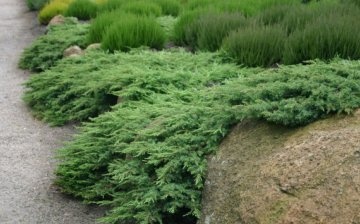
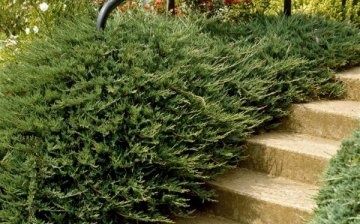







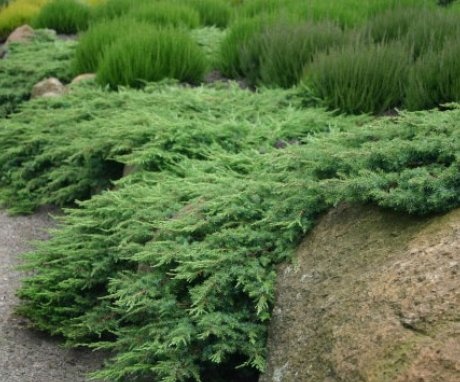
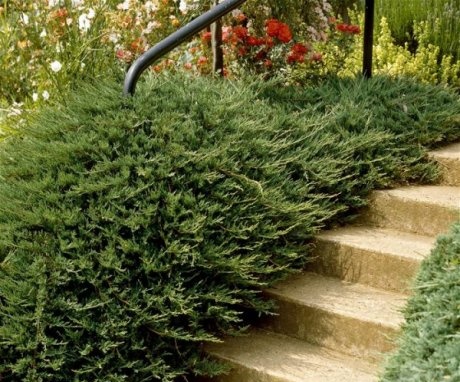
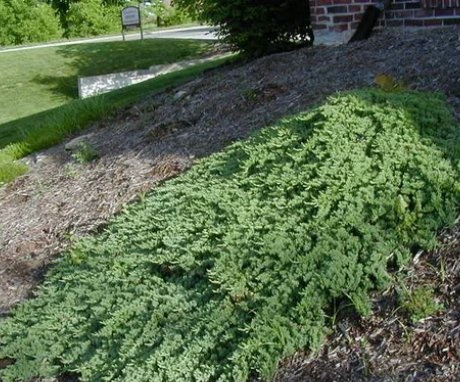
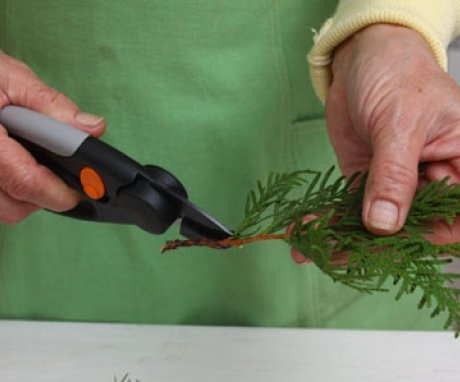
Juniper is an excellent plant for decorating a summer cottage. It is easy to root, durable and air-purifying. With his participation, you can form the most beautiful compositions.